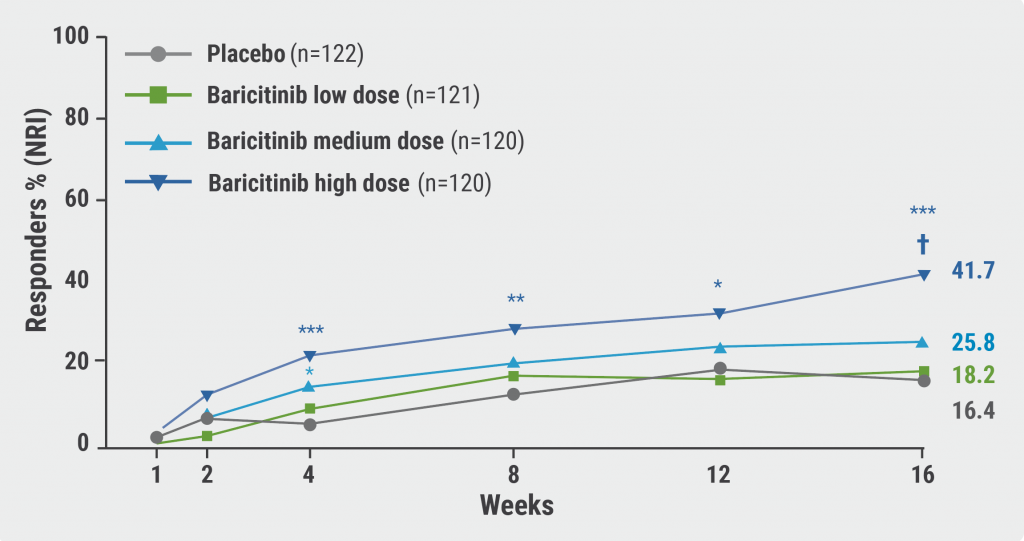https://doi.org/10.55788/5f18f06c
Within the TRuE-V1 (NCT04052425) and TRuE-V2 (NCT04057573) trials, ruxolitinib cream demonstrated superior efficacy over placebo at week 24, not only in the primary but also all secondary endpoints [1,2]. “We know that the location is very important when it comes to re-pigmentation of vitiligo, and we know that extremities are much more difficult, but also some other areas on the body,” Prof. Thierry Passeron (University Côte d’Azur, France) expressed as the underlying reason for an analysis of the data according to efficacy in different body regions [1]. The studies included vitiligo patients ≥12 years of age with ≤10% of depigmented body surface area of which at least 0.5% had to be facial and ≥3% in other body sites. For the new evaluation, endpoints were ≥50% improvement in the Vitiligo Area Scoring Index (VASI50) Score at week 24 in: head and neck, hands, upper/lower extremities, trunk including genitals, feet, as well as total body with exclusion of the face.
In TRuE-V1 and V2, participants were randomised to twice daily 1.5% ruxolitinib cream or placebo until week 24, whereafter all participants continued on the study drug to week 52. At 6 months, the results were in favour of the ruxolitinib cream as compared with placebo, regardless of the body region. Best results for ruxolitinib versus placebo at week 24 were noted in head and neck (45.3% vs 23.8%), followed by the extremities (arms 33.2% vs 8.2%, legs 29.5% vs 12.2%). Prof. Passeron highlighted that even hands and feet, 2 very resistant areas to treat, provided good results. As re-pigmentation treatment in vitiligo takes time, the results of the ruxolitinib groups further improved up to week 52: VASI50 was reached for total body without the facial area in 47.7%, head and neck 68.1%, upper extremities 56.7%, lower extremities 54.5%, trunk 48.4%, hands 38.2%, and feet 29.3%. In comparison, the respective rates for reaching VASI50 in former placebo patients changing to ruxolitinib at week 24 were: 23.3%, 51.0%, 34.9%, 32.3%, 25.4%, 29.2%, and 22.5%. “Not surprisingly, hands and feet that are the most difficult parts to re-pigment, but you can see that even so about one third of the patients reach 50% of re-pigmentation after 1 year of treatment,” Prof. Passeron underlined. Interestingly, the increase of patients reaching VASI50 over time did not plateau after 1 year.
“This subanalysis demonstrated that after 6 months and after 1 year, ruxolitinib cream provided not only good results on the face but also on other parts of the body, which is very important for the patients,” Prof. Passeron summarised, reminding the audience that it is important to explain to the patients that treatment will go on for a long time.
- Passeron T. Effect of Ruxolitinib Cream on Achievement of VASI50 by Body Region: Week 52 Pooled Analysis of the TRuE-V Phase 3 Studies. 1C, EADV Congress 2022, Milan, Italy, 7‒10 September.
- Rosmarin D. Efficacy and safety of ruxolitinib cream monotherapy for the treatment of vitiligo: results from 2 52-week phase 3 studies. S026, AAD 2022 Annual Meeting, Boston, MA, USA, 25–29 March.
Copyright ©2022 Medicom Medical Publishers
Posted on
Previous Article
« Markedly lower skin cancer risk in vitiligo patients Next Article
Notalgia paresthetica: may κ-opioid receptor agonists be a long-awaited effective therapy? »
« Markedly lower skin cancer risk in vitiligo patients Next Article
Notalgia paresthetica: may κ-opioid receptor agonists be a long-awaited effective therapy? »
Table of Contents: EADV 2022
Featured articles
Letter from the Editor
Psoriasis and Psoriatic Arthritis: What You Need to Know
Novel oral psoriasis drug maintains efficacy over 2 years
A3 adenosine receptor agonist showed modest efficacy but excellent tolerability
Selective IL-23 inhibitor achieves long-term disease control in many patients with active PsA
AI machine learning algorithm useful in early detection of PsA
Novel Developments in Sun Protection
Myths regarding “health benefit” of suntan prevail in majority of population
Fern extract reverses severe actinic keratosis lesions
Vitiligo in 2022
Enhancing re-pigmentation rates with topical ruxolitinib in all body areas
Markedly lower skin cancer risk in vitiligo patients
Pruritus Treatment: Novel Agents Entering the Arena
Dupilumab leads to clinically relevant improvements in signs and symptoms of prurigo nodularis
Nalbuphine: aspiring to become another treatment for prurigo nodularis?
Notalgia paresthetica: may κ-opioid receptor agonists be a long-awaited effective therapy?
Pharmacotherapy in Hidradenitis Suppurativa: New Opportunities
High potential for secukinumab as next biologic treatment for HS
Hidradenitis suppurativa: TYK2/JAK1 inhibitor shows promise
Best of the Posters
High rate of non- or partial responders jeopardises therapeutic success in HS
Genital psoriasis: high prevalence, often underdiagnosed
Decreased overall survival in melanoma patients with low vitamin D
News in Atopic and Seborrheic Dermatitis
Baricitinib possible therapeutic option for children with AD
Amlitelimab therapy leads to sustained decrease of IL-22 in AD patients
IL-13 inhibition with lebrikizumab shows high maintenance rates in AD
Does 8 weeks of emollients use prevent AD in high-risk infants?
Roflumilast foam led to high response rates in seborrheic dermatitis
What Is Hot in Hair Disorders?
Long-term improvement in alopecia areata with ritlecitinib therapy
Topical gel plus finasteride beneficial for patients with androgenetic alopecia
Deuruxolitinib achieves hair regrowth, even in patients with severe alopecia areata
Related Articles

November 5, 2022
Baricitinib possible therapeutic option for children with AD

November 5, 2022
Roflumilast foam led to high response rates in seborrheic dermatitis
November 5, 2022
Long-term improvement in alopecia areata with ritlecitinib therapy
© 2024 Medicom Medical Publishers. All rights reserved. Terms and Conditions | Privacy Policy
HEAD OFFICE
Laarderhoogtweg 25
1101 EB Amsterdam
The Netherlands
T: +31 85 4012 560
E: publishers@medicom-publishers.com

